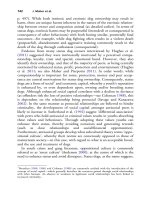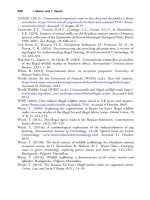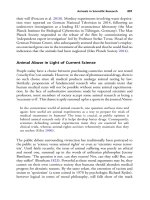The palgrave international handbook of a 114
Bạn đang xem bản rút gọn của tài liệu. Xem và tải ngay bản đầy đủ của tài liệu tại đây (36.5 KB, 1 trang )
104
A. Nurse
References
Agnew, R. (1998). The causes of animal abuse: a social-psychological analysis.
Theoretical Criminology, 2(2), 177–209.
Ascione, F.R. (1993). Children who are cruel to animals: a review of research and
implications for developmental psychopathology. Anthrozoos, 4, 226–227.
American Society for the Prevention of Cruelty to Animals [ASPCA] (2015).
Frequently asked questions about animal hoarding. Accessed 20 June 2015.
Beirne, P. (2004). From animal abuse to interpersonal violence? A critical review of
the progression thesis. Society and Animals, 12(1), 39–65.
Beirne, P. (2007). Animal rights, animal abuse and green criminology. In P. Beirne,
& N. South (Eds.), Issues in green criminology: confronting harms against environments, humanity and other animals. Devon: Willan Publishing.
Benton, T. (1998). Rights and justice on a shared planet: more rights or new
relations? Theoretical Criminology, 2(2), 149–175.
DEFRA [Department for Environment, Food and Rural Affairs]. (2009a). Code of
practice for the welfare of cats. London: Department for Environment, Food and
Rural Affairs.
DEFRA. (2009b). Code of practice for the welfare of horses, ponies, donkeys and their
hybrids. London: DEFRA.
DEFRA. (2009c). Code of practice for the welfare of dogs. London: DEFRA.
DEFRA. (2010). Code of practice for the welfare of privately kept non-human primates.
London: DEFRA.
Donaldson, S., & Kymlicka, W. (2011). Zoopolis: a political theory of animal rights.
Oxford: Oxford University Press.
Farrington, D. P. (2002). Developmental criminology and risk—focussed prevention. In M. Maguire, R. Morgan, R. Reiner (Eds.), The oxford handbook of
criminology. 3rd edition. Oxford: Clarendon Press.
Francione, G.L. (2007). Animals, Property and the Law, Philadelphia: Temple
University Press.
Frasch, P.D. (2000). Addressing animal abuse: the complementary roles of religion,
secular ethics, and the law. Society & Animals, 8(3), 331–348.
Hall, M. (2013). Victims of environmental harm. In R. Walters, D. Westerhuis,
T. Wyatt (Eds.), Emerging issues in green criminology: exploring power, justice and
harm. Basingstoke: Palgrave Macmillan.
Hawksworth, D., & Balen, R. (2009). Animal cruelty and child welfare: the health
visitor’s perspective. In A. Linzey (Ed.), The link between animal abuse and human
violence (pp. 281–294). Eastbourne: Sussex Academic Press.
Ibrahim, D.M. (2006). The anti-cruelty statute: a study in animal welfare. Journal of
Animal Law and Ethics, 1(1), 175–203.









